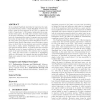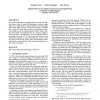WWW
2002
ACM
15 years 9 days ago
2002
ACM
WWW
2002
ACM
15 years 9 days ago
2002
ACM
Real-scale Semantic Web applications, such as Knowledge Portals and E-Marketplaces, require the managementof large volumes of metadata, i.e., information describing the available ...
WWW
2002
ACM
2002
ACM
Flash crowds and denial of service attacks: characterization and implications for CDNs and web sites
15 years 9 days ago
The paper studies two types of events that often overload Web sites to a point when their services are degraded or disrupted entirely - flash events (FEs) and denial of service at...
WWW
2002
ACM
15 years 9 days ago
2002
ACM
WWW
2002
ACM
15 years 9 days ago
2002
ACM
In the original PageRank algorithm for improving the ranking of search-query results, a single PageRank vector is computed, using the link structure of the Web, to capture the rel...
WWW
2002
ACM
15 years 9 days ago
2002
ACM
Richly interlinked, machine-understandable data constitute the basis for the Semantic Web. We provide a framework, CREAM, that allows for creation of metadata. While the annotatio...
WWW
2002
ACM
15 years 9 days ago
2002
ACM
We present an algorithm for translating XSLT programs into SQL. Our context is that of virtual XML publishing, in which a single XML view is defined from a relational database, an...
WWW
2002
ACM
15 years 9 days ago
2002
ACM
The structure of the web is increasingly being used to improve organization, search, and analysis of information on the web. For example, Google uses the text in citing documents ...
WWW
2002
ACM
15 years 9 days ago
2002
ACM
WWW
2002
ACM
15 years 9 days ago
2002
ACM


